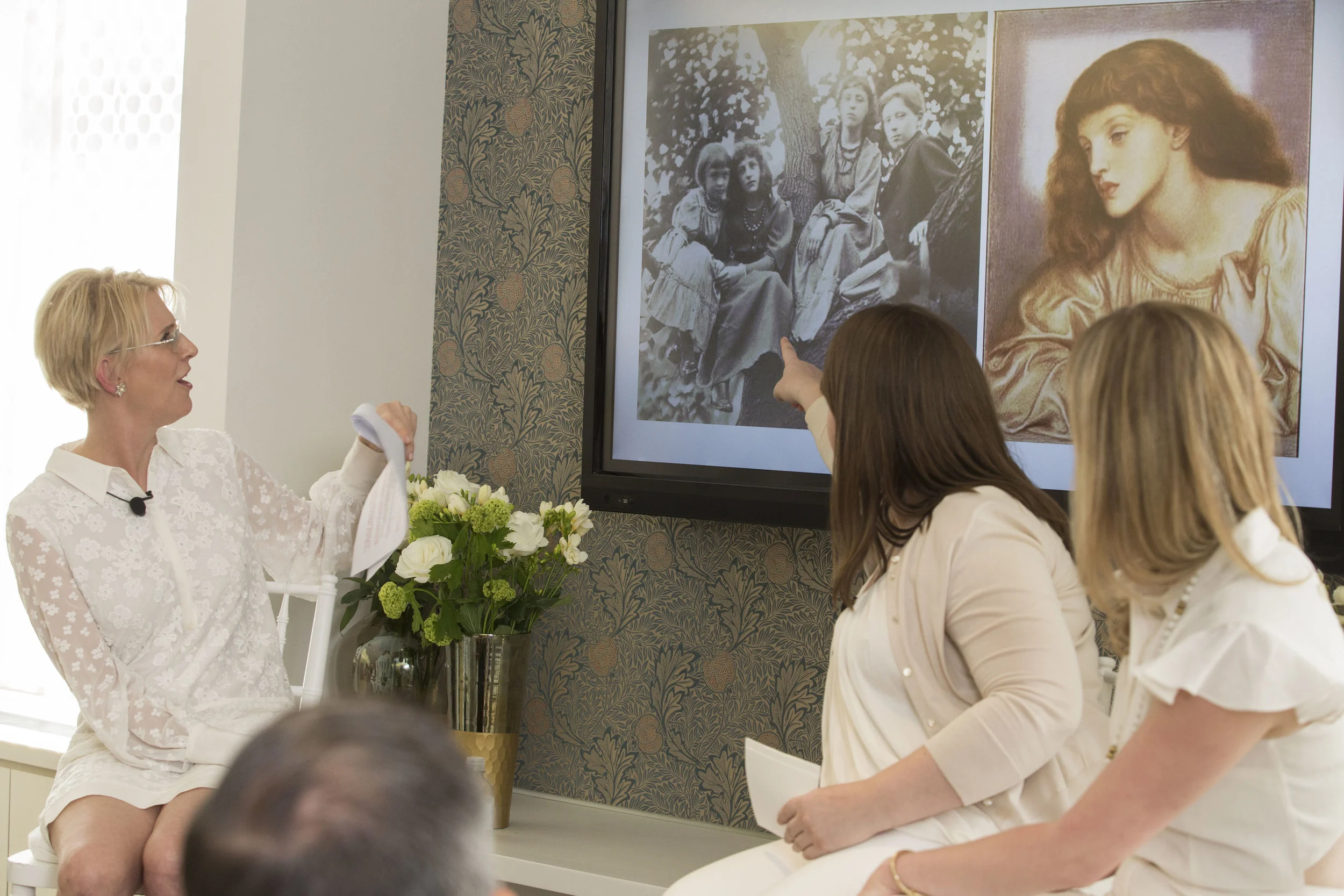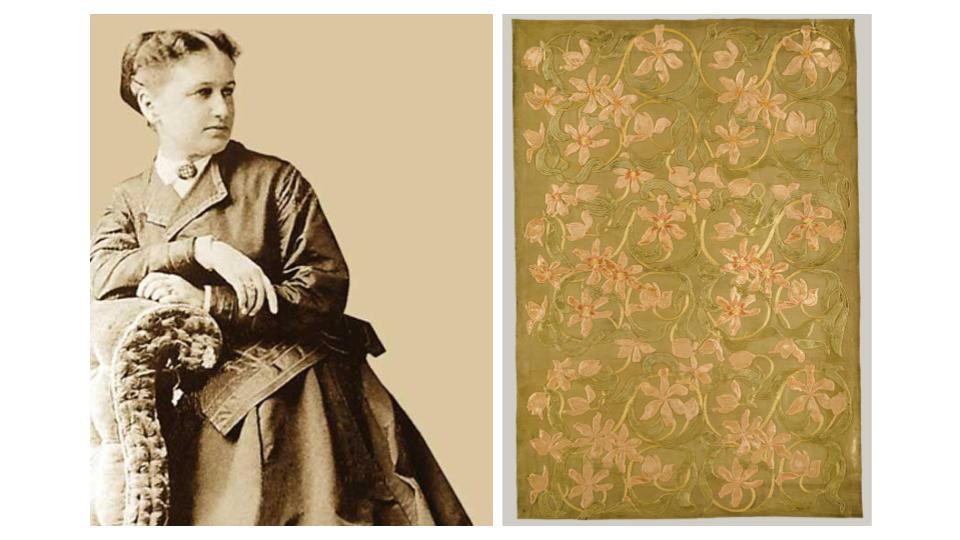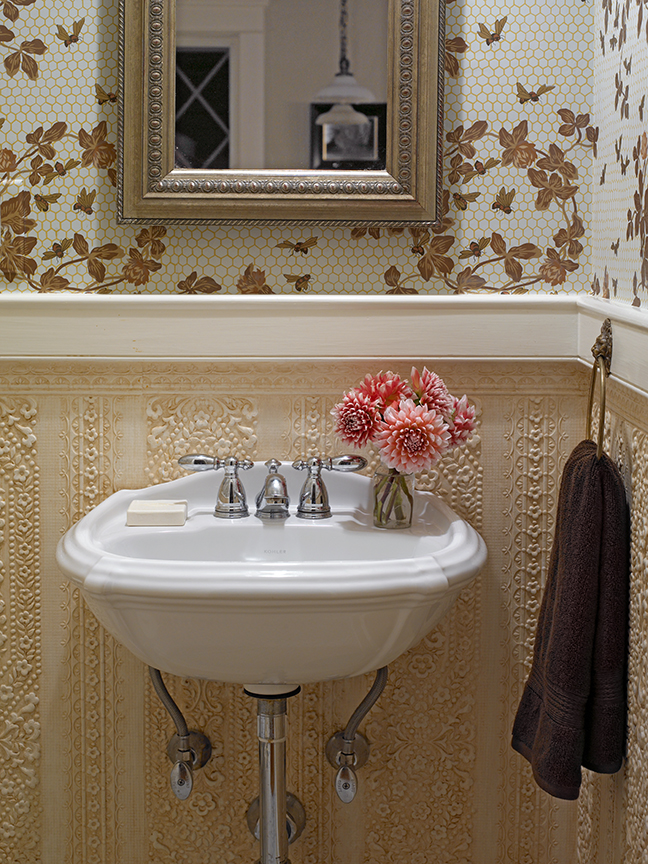Who Are the 5 Women From the Past Who Made the Interior Design Industry What It Is Today?
Panel discussion at Style Library on the legacy of women in design.
There wouldn’t be a design industry today without the efforts of some key women, the first of whom began trailblazing in the late 1880s. Late last May, I was honored to moderate a standing room only panel at NYC’s D&D building on the legacy of women in design. Settle in for a quick primer on the 5 leading ladies in interior design history.
1. May Morris
May Morris, second from left and painted by Pre-Raphaelite painter, Rossetti
May Morris hard at work at home.
First up is May Morris, William Morris’ daughter. Around 1880, at age 23, William put her in charge of the embroidery department at Morris & Co. where she managed a team of women. May is accredited with establishing embroidery as an art form with patterns that are still produced today. Back then a girl boss was revolutionary.
May Morris’s popular Honeysuckle pattern. Many people erroneously think her father William Morris designed it.
When her father died in 1896, May Morris left Morris & Co. to concentrate on her own pursuits and, eventually, she became a champion of working rights, especially women’s. In 1907, she established the first Women’s Guild of Arts—no existing guild at the time would admit women. For the first time, women’s sewing abilities were given professional recognition. It was a start.
2. Candace Wheeler
Stateside, Candace Wheeler made similar strides. She founded the Society of Decorative Art and the New York Exchange for Women’s Work and co-founded Associated Artists (aka, Tiffany and Wheeler) with Louis Comfort Tiffany. Her designs were installed in such illustrious places as the White House and Mark Twain’s house. (And an old powder room of mine). She saw it as her role to give women a place in industry, and like May Morris, she helped establish a profession in handcraft and textile arts.
3. Elsie de Wolfe
Elsie is the first true interior designer. She once told Billy Baldwin, “you are a fool if you do anything for anybody without receiving a commission”. Prior to her, the interiors of a home where handled by upholsters and other finishers who were often retained –and controlled-- by architects.
Elsie was an untrained actress known for her great fashion sense. Her break out commission was decorating the ladies club, the Colony Club, where she lined the dining room with trellis and chose chintz and pastels over heavy saturated colors and fabrics. Famed architect Stanford White who designed the building declined the commission and said to leave it all to Elsie. She became a millionaire after she completed the Frick Mansion (now Musuem) for Henry Clay Frick.
A pretty interior designed by Henry & Co inspired by Elsie de Wolfe.
4. Eleanor McMillen Brown
Eleanor McMillen Brown launched her company in 1924, calling it McMillen, Inc because she wanted to run her business professionally, and not be one of those ladies “who worked out of her living room.” She graduated from Parsons and insisted that her employees be formally educated. McMillen, Inc is still in business today and we can credit Eleanor for establishing the design industry’s professional standards.
A classic room by McMillen Inc.
A bedroom recently designed by McMillen Inc.
5. Dorothy Draper
For better or worse, it is Dorothy Draper who can be called the first design celebrity. She was photographed and published more than any other interior designer (regardless of sex) in her day.
Dorothy is the precursor to today’s designer cum “influencer” and “tastemaker”. Her weekly newspaper columns were read by the masses like today’s blogs and Instagram. She championed DIY tips such as cutting down the legs of old antique tables to coffee table height and bleaching out old oriental rugs for a new look. I will let you decide what you think of those ideas.
Later Dorothy complied her tips into a bestselling book entitled Decorating is Fun. She also struck the first licensing deals—her name appeared on wallpaper, fabrics, even gift wrap. Perhaps most significantly she made her biggest splash with commercial projects like hotels and restaurants, an area previously dominated by men.
A bathroom designed by Young Huh shows how Young spins some Draper motifs.
Conclusion
These women led to the design industry that we know today. I challenge you to name 5 men who made comparable contributions to the business. Girl Power!!
Panel discussion photos by Christopher Patrick. My powder room by Ellen McDermott.















